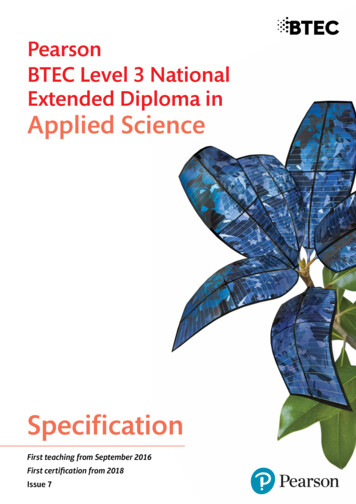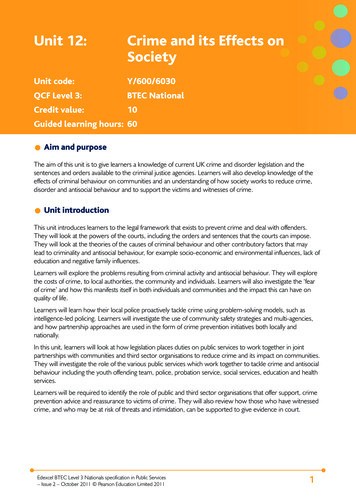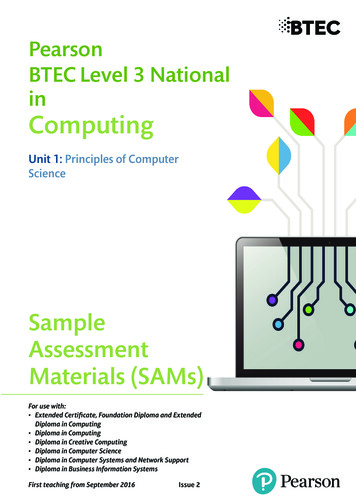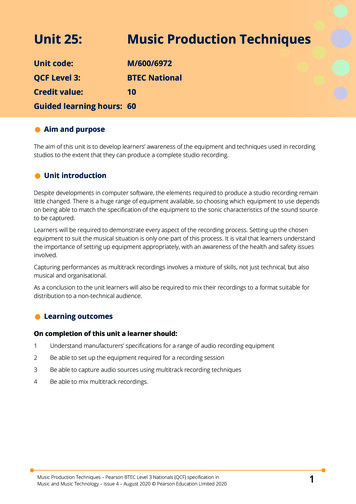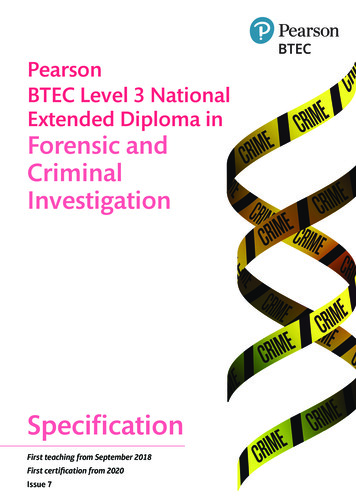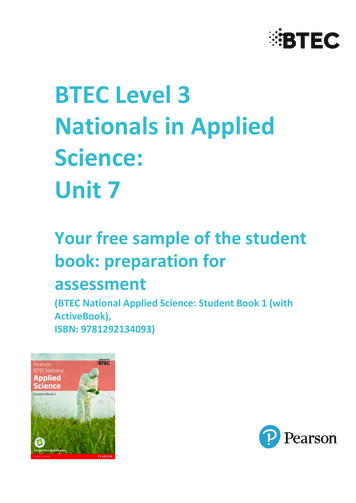
Transcription
BTEC Level 3Nationals in AppliedScience:Unit 7Your free sample of the studentbook: preparation forassessment(BTEC National Applied Science: Student Book 1 (withActiveBook),ISBN: 9781292134093)
UNIT 7Getting ready for assessmentThis section has been written to help you do your best when you take your finalassessment test. Read through it carefully and ask your tutor if there is anythingyou are not sure about.About the testHere is a brief summary of the Unit 7 assessment. It is divided into two parts.Part AYou will be given your source booklet before your assessment. This will containarticles all relating to a contemporary scientific issue. You should complete thefollowing tasks. Plan your time carefully! Read the articles several times. Analyse them in the context of how thescientific issue is being tackled, the intended audience of the article and thevalidity of the scientific content, including organisations and people whomay be mentioned. You can highlight or annotate your articles. Here aresome examples of how you might approach doing this. You must do further research. You need to find out about any organisationsor scientists mentioned in the articles and decide how valid their opinionsmight be and how influential they are. You can also look for reliable evidencewhich confirms or refutes the ideas put across in the articles provided.Part BYou complete your taskbook which contains copies of the articles. It must becompleted independently and under supervised conditions. You write youranswers directly into the taskbook, which is then submitted for assessment. Thequestions are all based on the articles provided. Different questions are givendifferent numbers of marks. Make sure you spend most of your time on thequestions where you can gain most marks.The areas most likely to be highlighted in the questions include: The implications of the scientific issue or issues in the articles The organisations/individuals mentioned in the articles and their potentialinfluence on the scientific issue The validity of the judgements in one or more of the articles Possible future areas for development or research linked to the mainscientific issue Your understanding of the scientific issues and ability to explain themto a given audience.162Contemporary Issues in ScienceQuestions coveringthese issues will carrythe most marks.
Annotating the Part A ArticlesHere are some sections from three articles on treating malaria. Read themthrough and see how they have been highlighted and annotated. This gives youan idea of the task you will have to complete.Article 1: What is Malaria?Every 2 minutes a child dies from malaria - a disease spread by a singlemosquito bite. Nothing But Nets works with supporters and partners around theworld to raise funds and awareness about the disease and advocate for malariaprevention.This student has usedyellow highlighting toshow the organisationsthey want to look up.Malaria is a disease caused by the blood parasite Plasmodium, which istransmitted by mosquitoes. Each year, an estimated 219 million people areinfected with malaria, causing approximately 600,000 deaths – mostly childrenunder the age of five.Here the student hasunderlined the mainscience issues explainedin the text. . . . Every 2 minutes, a child in Africa dies from a malaria infection and 90% ofall malaria deaths occur in the region. When combined with HIV/AIDS, malaria iseven more deadly, particularly for pregnant women and children.Malaria is a big problem – and the disease has big consequences for families,communities, and countries. Fortunately, there are small things that can helpmake a huge impact in the fight against malaria. It’s easy to help: Nothing ButNets works with our UN partners to prevent malaria in Sub-Saharan Africa bysending nets to save lives and raising voices to let policymakers know that thefight against malaria is important. Learn about the many ways you can takeaction now!Did you know?Four Nobel Prizes have been awarded for work associated with malaria toSir Ronald Ross (1902), Charles Louis Alphonse Laveran (1907), Julius WagnerJauregg (1927), and Paul Hermann Müller (1948).The two most effective and potent anti-malaria drugs come from plants withmedicinal values recognized for centuries: artemisinin from the Qinghao plantand quinine from the cinchona tree.The student is usinga different colouredhighlighter to show upindividuals involved inmalaria research.How Is Malaria Prevented?In the poorest parts of the world, window screens are lacking, anti-malariadrugs are expensive, and so far an effective malaria vaccine does not exist. Infections can be prevented by sleeping under long-lasting insecticide-163
UNIT 7treated bed nets (LLINs). These nets, which are designed to last at least threeyears, work by creating a protective barrier against deadly malaria-carryingmosquitoes that typically bite at night.The benefits of these bed nets extend even further than protecting thosesleeping underneath them. The insecticide woven into each net makes entirecommunities safer – killing mosquitoes so that they can’t go on to bite otherswho may not be protected by a net. Bed nets can reduce malaria transmissionsby as much as 90 percent in areas with high coverage rates. It costs just 10 tosend a bed net to the families who need them. According to the 2012 WorldMalaria Report, 90 percent of people with a bed net use it. Join us now. Send anet and save a life.Other Prevention Measures and TreatmentIn addition to bed nets, malaria can be prevented by applying insecticide tothe inside walls of individual homes. Mosquitoes that land on treated walls arekilled, preventing the transmission of malaria. Source: Nothing but nets, charity involved in reducing and preventing the spread of ives/what-is-malaria.htmlArticle 2: Drug-resistant malaria an ‘enormous threat’ —vigorous international effort needed to contain itA drug-resistant form of malaria is spreading in southeast Asia and representsan “enormous threat” to the world.The resilient form of the mosquito-spread parasite has been found in many partsof Myanmar (Burma) as well as Cambodia, Thailand, Laos and Vietnam.The drug artemisinin is normally given as part of a combination therapy tobattle the disease, but now a strain of the parasite is not responding to it.The alarming discovery is a major blow to global health efforts to reduce thenumber of deaths from the mosquito-spread parasite.Although initially other drugs given in the combination treatment could keepmalaria at bay, the parasite is likely to develop resistance to the partner drugsas well - and there’s evidence that this is happening already.Health workers fear that the strain could soon spread to India, where thousandsmore lives would be at risk.164Contemporary Issues in ScienceMore underlining showsup a different aspect ofthe malaria story.
“It’s hugely worrying,” says Professor David Conway from the London School ofHygiene & Tropical Medicine, “both for people in southeast Asia and the rest ofthe world.”“Should these [drugs] fail today, there’s nothing waiting in the wings that’sgoing to be affordable and adequately tested in time.”The London School ofHygiene and TropicalMedicine has anexcellent reputation.Something similar happened in the 1950s, when malaria became resistantto a drug called chloroquine. It spread across the world and eventuallyreached Africa.“The global spread of chloroquine resistance resulted in the loss of millionsof lives in Africa and, clearly, Myanmar is an important part of the frontlinein the battle to contain artemisinin resistance,” say the authors of the study,published in the Lancet Infectious Diseases.“A vigorous international effort to contain this enormous threat is needed,”they say.The student highlightsa publication quoted inthe article to look uplater.Conway adds: “It’s not too late, but action needs to be taken now to stopthe spread.”Healthcare workers should make sure that malaria isn’t being treated withartemisinin on its own (which is happening in some places “against all advice”),and efforts should be made to eliminate counterfeit medicines.Continued molecular testing of the strain in real-time and monitoring patientsin other territories, particularly Africa, for resistance is vital.Source: 706Article 3: The ongoing battle against drug-resistant malariaArtemisinin-based combination therapyArtemisinin-based combination therapy (ACT) has been integral to the recentsuccesses in global malaria control. The main idea behind ACT was to provide aninexpensive, short-course treatment that would also help protect against thedevelopment of drug resistance Here the student isusing a different patternof underlining to showup where one articlereinforces another.Is history repeating itself?In 2009, researchers reported concerns that artemisinin was taking longer toclear parasites from patients infected with Plasmodium falciparum along theThailand-Cambodia border — a worrying sign of emerging drug resistance.Since then, researchers have reported slow parasite clearance in four countriesin the Greater Mekong Subregion What’s more, if artemisinin resistance were to arise in Africa or emergeindependently elsewhere, as has happened with other antimalarial drugs, thepublic health consequences would be catastrophic In response to this threat, the World Health Organization (WHO) launched anemergency plan of action to tackle artemisinin resistance in the Greater MekongSubregion covering 2013–2015. They proposed an immediate and coordinatedincrease in efforts to tackle malaria in Cambodia, Laos, Myanmar, Thailand andVietnam. Currently the WHO’s goal is to initiate elimination activities by 2020 inorder to remove malaria completely from Greater Mekong Subregion countriesby 2030.The World HealthOrganization needslooking up, then makenotes about it.165
UNIT 7But how are we going to stop the spread of drug resistance if we haven’t beenable to in the past? Well, now we have one more weapon in our arsenal that wedidn’t have before – genome sequencing!Genomics vs. malaria – the fight is onAt the time that artemisinin resistance was first discovered in early 2009, noone knew which genetic changes were responsible, and pinpointing thosechanges proved more challenging than expected. However, faster and cheapergenome sequencing techniques have enabled us to learn a lot more about theunderlying genetic changes responsible. By finding these genetic changesscientists are hoping that they may eventually be able to track and thenprevent the spread of artemisinin resistance.Clues on chromosome 13In 2012, and then again in 2013, a couple of genome-wide association studies(GWAS) looking at the P. falciparum genome pointed towards two regions nextto each other on chromosome 13 as potential sites of the mutations associatedwith artemisinin resistance. However, they needed to find out for sure if thesemutations were directly involved in resistance. A year or so later, a collaborationled by scientists at the Institut Pasteur in Paris came up with an experimentthat pointed them in the right direction.The Institut Pasteurneeds looking up, thenmake notes about it.Over a five year period, the scientists grew and nurtured a strain of Plasmodiumparasite that they knew did not have any resistance to artemisinin. Every sooften during this period they gave the colony of parasites a small amount ofartemisinin. They hypothesised that sooner or later an artemisinin resistantparasite would emerge because of the selection pressure of the drug (thepressure to adapt in order to survive!). Sure enough, after four years ofexposure to the drug, artemisinin resistant parasites were seen. With DNAsequencing they were then able to study the genome of the resistant parasitesand compare them to the genome of the original, non-resistant strain ofPlasmodium.They found several genetic changes in the resistant parasite genome but themost significant one occurred bang in the middle of the previously-identifiedregions on chromosome 13, in a gene called kelch13.Like spies in an enemy country, genomics can provide us with the intelligence totrack drug resistance emerging in the malaria parasite. This gives us more timeto plan our counterattack before drug resistance becomes more widespread.Source: le-against-drug-resistant-malariaRevising for your testIn most exams the questions you have to answer depend on you learningabout a particular aspect of science, and being able to answer questions on it.So before the exam, you have to revise the topic thoroughly. Unit 7 is ratherdifferent. The questions in the test are based on the skills which you havedeveloped in researching and identifying key points of information from anextensive passage of text. They do not significantly test your knowledge of thesubject material, so you will not be expected to recall information.166Contemporary Issues in ScienceIs this website reliable?More research isneeded!
The best way to revise for the test is to work through the research anddiscussion sections in this unit, making sure that you understand the keydifferences in scientific reporting and issues involved in scientific developmentincluding: both sides of the issues involved – the positives and the negatives the overall quality and balance of reports including any coverage of dataanalysis, sampling and supporting evidence the reporting medium used and corresponding target audience the presentation of science reports.Making notesYou may not have to learn all the science in Unit 7 by heart – but you doneed to practise doing research and making notes. Always bear in mind thequestions you are likely to be asked. You need to link all the information to thespecific article it comes from. Here is a sample of some early notes made by astudent .Notes for Unit 7 assessment1 The main science issue is the problem of malaria and thedevelopment of drug-resistant strains of the parasite whichcauses the disease e.g. In Article 1: an estimated 219 millionpeople are infected with malaria, causing approximately 600,000deaths – mostly children under the age of five. In Article 2: A drug-resistant form of malaria is spreading insoutheast Asia and represents an “enormous threat” to the world.In Article 3: Resistance to antimalarial drugs is one of thebiggest problems currently facing malaria control. The secondary issues include how do we treat or prevent malariaand how can we deal with the problem of the drug resistantparasites 2 Scientific organisations mentionedArticle 1 WorldHealth Organization (WHO): WHO is a specialised partof the United Nations and is very influential. – it collectsdata on diseases from all over the world and issues guidelinesfor treatments, flags up epidemics and pandemics etc. It puttogether the 2012 World Malaria Report based on data from 104countries with endemic malaria. VERY influential globally (WHOpublications website, Wikipedia).167
UNIT 7Article 2 London School of Hygiene and Tropical Medicine: world-leadingcentre for research into tropical medicine and public health.Part of the University of London. Founded 1899. Research carriedout here has big impact all over the world (2016 CWTS LeidenRanking for research impact).Article 3 World Health Organization (WHO): see Article 1 Institut Pasteur: in Paris, internationally renowned forresearch into microbiology and disease – based on the work onmicrobiology, vaccines etc of Louis Pasteur.Have a go and see if you can build up your own notes based on the articles.Sample questions and answersRemember: These examples are much shorter than you would write in yourexam, because they are only based on single-page articles.1 Discuss the implications of the scientific issue described in the article. 12 marksUse your notes to remind yourself about the main issues in the threearticles. Make sure you refer to all three of the articles and to otherreading you may have done. This question carries a lot of marks soplan your timing and your answer carefully.To score well you need to draw a wide range of links to and betweenthe ethical, social, economic and/or environmental implications of thescience. You are assessed on the structure of your answer which shouldbe clear, coherent and logical so plan carefully.The main scientific issue identified in these three articles is thespread of drug-resistant malaria in many parts of the world. Thereare two aspects to this issue. One is the problem of malaria as aglobal disease. Every year around 219 million people are infected withmalaria, causing approximately 600,000 deaths. Malaria is a diseasecaused by the blood parasite Plasmodium, which is transmitted bymosquitoes. Most of the deaths are in children under 5 years old.The level of disease in populations affects society because people aretoo ill to work effectively and look after their children. Economicallythis affects families and countries. Individuals can’t make enoughmoney to support their families, and countries cannot build secureeconomies.The other problem is treating malaria successfully. It is common inpoor countries for example on the continent of Africa and areas suchas Cambodia and Myanmar. One line of defence is to try and stopthe spread of mosquitoes as effectively and cheaply as possible – forexample using insecticide impregnated mosquito nets. Other methodsinclude general insecticides and anti-malarial drugs. Although these168Contemporary Issues in ScienceStudent has read andsummarised the articlemain points effectively.Student has lookedat the problem andidentified issues,avoiding bias.
can be expensive, combined anti-malarial therapies can be veryeffective. Unfortunately, forms of the malaria parasite are evolvingwhich are resistant to our best anti-malarial drugs, and this is abig problem going forward. Solutions will depend on hi-tech genomeanalysis, which is expensive. This raises environmental issuesbecause insecticides can have damaging effects on the environment.It also raises ethical issues because the countries which most needthe solutions are also very poor.Student recognisessome of theenvironmental andethical issues ofpotential solutions.2 Identify two organisations and two scientists mentioned in the articlesand suggest how they may have had an influence on the main scientificissues. 6 marksLook back at your notes to remind yourself about the organisationsand individuals mentioned in the three articles.If you have made good notes, you will have these organisations andindividuals already identified, which will make answering this type ofquestion much easier. To score highly you need to make clear linksbetween the institutions and people mentioned and the original articles.Two examples of influential organisations mentioned in thearticles are:The World Health Organization, known as the WHO, is a specialisedpart of the United Nations and is very influential. It collects data ondiseases from all over the world and issues guidelines for treatments,flags up epidemics and pandemics etc. It put together the 2012 WorldMalaria Report based on data from 104 countries with endemicmalaria. VERY influential globally (WHO publications website,Wikipedia)The London School of Hygiene and Tropical Medicine is mentionedin Article 2. It is a world-leading centre for research into tropicalmedicine and public health. It is part of the University of Londonand it was founded in 1899. It specialises in tropical diseases suchas malaria and specialist scientists come here from many differentcountries to study these diseases and how to treat them. Researchcarried out here has a big impact all over the world.Two examples of influential scientists mentioned in the articles are:Sir Ronald Ross (1902), the doctor who demonstrated that malariais spread by mosquitos. His work allowed people to begin to work outhow to prevent the spread of the disease. (Wikipedia, Nobel prizeweb site)Professor David Conway is very active in anti-malaria research. Heis professor at the London School of Hygiene and Tropical Medicine,works in UK and African countries, has published over 170 researcharticles, and is well known in his field (LSHTM website).169
UNIT 73 Discuss whether the articles are expressing valid concerns about theproblems linked to treating malaria. In your answer you should consider: How the articles have interpreted and analysed the scientificinformation to support the conclusions/judgements being made The validity and reliability of data References to other sources of information. 12 marksUse your notes to remind yourself about the validity of the articles.What does validity mean? What will you be looking for? Make sure yourefer to the points made in the bullet points given to guide your answer.Look at your comparison of the three articles to help you highlight themain points you need to answer this question well. You will be assessedon the structure of your discussion as well as the content. It mustbe clear, coherent and logical. Make sure you take the time to plancarefully.If results are valid they measure what they are supposed to measure.If results are reliable, the investigation produces stable, consistentresults which other people can replicate. It is important to be surethat an article is valid and reliable before you take any notice of it.There is considerable agreement between the three articles, which initself suggests that the conclusions are probably reliable.Article 1 was published on a website by a charity which workswith the UN. They are trying to raise money to supply insecticideimpregnated mosquito nets in Africa to help prevent the spread ofmalaria. Charities should use reliable data but they are trying topersuade you to give money so it is important to double check theirsources as they may be biased in their choice of evidence. When thedata is published in reliable journals or on websites it suggests thecontent will be valid. Article 1 refers to the 2012 Malaria Reportfrom the WHO – a very reliable source because it collects valid datafrom all over the world. However, much of the information it givesabout malaria is supported by the other two articles, which increasesits validity.Student explains whatvalid data is and why itis important.Student shows they areaway of the possibilityof bias in an charity.Article 2 is taken from the website of a popular newspaper. Notall science articles in newspapers are reliable so it is importantto check the sources used and the way they are interpreted. Thisarticle focuses on the drug-resistant strains of the malaria parasitespreading from Myanmar. It quotes at least two reliable sources: report based on work by Professor David Conway - very reputable,LSTM report from a study published in the Lancet Infectious Diseases,a very reputable scientific journal which only publishes peerreviewed valid work.170Contemporary Issues in ScienceStudent highlights anumber of reputablescientists and sourcesin all three articles.
Although the article is for a popular newspaper website, it uses thehighly reliable sources it has chosen as evidence for its conclusions- that there is a global risk as a result of the emergence ofartemisinin resistance in malarial parasites. These conclusions arealso backed up in Article 3, suggesting that although they are partof the popular media aimed at a non-scientific readership, they arenevertheless valid and reliable. The article finishes by stating thatthe continued molecular testing of the malarial parasites, especiallyin Africa, is vital. This is not supported or explained in this article,but there is a lot more about it in Article 3 with good backingevidence.Article 3 is published on the www.yourgenome.org website developedby the education team at the Wellcome Trust Genome Campus. Thisis the top institution globally for analysis of the genomes of differentorganisms, and it has many internationally renowned scientistsworking there on various projects. That alone suggests that thecontent will be both valid and reliable, and that any conclusionsdrawn will be supported by evidence. Reading through the article,evidence and data are presented from a variety of sources includingthe Worldwide Antimalarial Resistance Network of the WHO andNature Genetics, a highly reputable peer reviewed journal.The sources quoted in this article are very reliable. The content alsoconfirms the impact of malaria, some of the problems in preventingmalaria and the problems of drug-resistant malaria parasitesdescribed in Articles 1 and 2. For example, Article 3 quotes vectormanagement as well as effective antimalarial drugs as an importantreason why death rates from malaria have fallen by 47% sincethe year 2000. This reinforces the message in Article 1 about theimportance of simple methods of vector control such as insecticideimpregnated mosquito nets. Later in Article 3, it confirms theconclusion in Article 2 that malaria parasites have become resistantto various drugs and that the current drug resistance has emergedfrom South east Asia. Article 3 gives us a lot more information onthe genetic basis for the development of drug resistance in malarialparasites. Considering where the article was developed, and thequoted sources, we can be fairly certain that the judgement madein the article that genome analysis of the malaria parasites is avital tool in the ongoing battle against drug-resistant malaria iscompletely justified.Student makesjudgements on thesources quoted in thearticles based on goodevidence.4 Suggest possible areas for further development or research related tothe scientific issue covered by the articles. 5 marksLook back at your notes – when you were reading the articles andmaking notes you will have thought about potential future developmentand research. In this answer you can suggest more than one directionfor future R&D. You will need to justify your choices/explain why thatresearch is needed. You are expected to link your ideas for furtherdevelopment/research to science from all three articles.171
UNIT 7The big problems highlighted in these articles are the issues ofmalaria – the toll it takes on human lives and the economies ofaffected countries – and the growing problem of drug resistance inthe malarial parasite which causes the disease.Here are some potential areas for further research and/ordevelopment:New drugs to cure malaria which work in a different way to thecurrent medicines. This would mean that even the malarial parasitesresistant to the current drugs would be wiped out as they would nothave resistance to the new drug mechanism. A new drug like thiscould be used in combination with a current anti-malarial drugso it continues to be effective. This would be similar to the use ofpiperaquine with artemisinin.Genome analysis to find out where the drug resistance genes arefound.Genome analysis reveals the DNA sequences of the malarialparasites. We can use this information to show us when themalarial parasite begins to develop resistance to a drug and changethe treatments used in this area. Then scientists can use thisinformation to help develop potential medicines and vaccines.Development of new insecticides to be used on water or on mosquitonets. We need new insecticides which are safe in the environmentand safe for people but effective at killing mosquitoes.5 Write an article for a tabloid newspaper on the growing problems ofmalaria based on the information contained in these articles. You willneed to identify: the target audience the level of language to be used amount of detail and accuracy what titles or captions may appeal to your target audience. 15 marksThink carefully about your target audience. Plan what you want them toknow. You will need a good headline to catch your reader’s attention.Decide how you can include good, valid, reliable science but stillmake your article interesting – you want people to keep reading tothe end. Use information from all three articles – show the examinersthat you have read and taken in information from all your sourcesand understand where they agree and where they take differentapproaches. If you can, include some extra information from yourreading around.You MUST keep your tone, style and level of scientific terminology thesame throughout the article – don’t start off all chatty and then end upwriting as if you are delivering a piece for a scientific journal!You will get credit for a well-organised article, with a clear, logical,coherent structure – so make your planning time count.172Contemporary Issues in ScienceStudent has highlightedthe problem andsuggested threeinteresting anddifferent areas forfurther research anddevelopment, showingevidence of researchingthe subject andunderstanding theissues.
A malarial time-bomb – and it could affect YOU!Choose a big, bold headline if you are writing a newspaper article –this one uses emotive terms like ‘time-bomb’ and makes it feel personalto people with the use of the emphasised ‘YOU’.Every year about 600,000 people die of malaria. Most of them arechildren under 5 years old. The World Health Organization estimatesthat around 219 million people are infected with malaria. It iscaused by a tiny parasite, spread by the bites of infected mosquitos.Malaria wrecks individual lives and destroys economies when manyof the working population are infected with this dreadful disease.So what? Malaria doesn’t affect us here in the UK – but only becauseit is too cold for the mosquitos which carry the malaria parasite tosurvive. But in Shakespeare’s times malaria (the ague) was common.As global warming increases, our old enemy could return – with avengeance.This is only the startof this answer. It isimportant to keep goingin the same tabloidstyle!173
world to raise funds and awareness about the disease and advocate for malaria prevention. Malaria is a disease caused by the blood parasite Plasmodium, which is transmitted by mosquitoes. Each year, an estimated 219 million people are infected with malaria, causing approximatel


